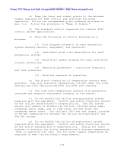
MIL-HDBK-1003/3
APPENDIX C (Continued)
not be installed as designed, (2) the system is installed to meet
requirements of the design and submittals but quality of
workmanship is such that the system will not function properly,
and (3) although construction might be satisfactory in all
respects, acceptance testing is of poor quality and latent
defects in the systems go undetected.
d) Operation and maintenance deficiencies can occur
from insufficient or improper training, the system receiving
inadequate operating and maintenance attention, and the system
receiving well meaning but misguided operation and maintenance
attention.
e) A failure in any of these areas can be fatal to the
successful operation of a VAV system.
C-1.04 System Simplicity. The most common fault of the
majority of designs is that the systems are too complicated to
work reliably. Some systems never work initially, others fail
because Naval operation and maintenance personnel do not
understand them sufficiently to keep them working as designed.
The chief area of concern is control systems. A designer is
always tempted to add features to improve performance and
conserve energy but must weigh the potential benefits against the
additional cost and complexity. Feedback: On the average,
systems have too many features and are too complex for the needs
of the Navy. The designer should design systems that err toward
simplicity, at the expense of features, and require minimum
maintenance.
C-1.05 Early Coordination. Having experienced numerous
problems on VAV systems, the Navy wishes to have a high level of
interaction between the designer and the Engineer in Charge and
will often want to give the designer more direction than is
normal. To minimize design changes, it is important that there
be good communication. This is particularly true in the early
stages of the design. The designer shall communicate his design
intent and the critical concepts of his proposed system,
including simplicity in operation and maintenance, at the first
submittal opportunity. This will prevent the necessity of
changing the concept of the design.
C-1.06 Dry Climates. Many Naval facilities are located in
humid climates and so there is a tendency to tailor design
guidance for humid areas. There are also many Naval facilities
located in dry and cold climates. The practice associated with
design in these facilities can be considerably different. The
173
Simpo PDF Merge and Split Unregistered Version - http://www.simpopdf.com

MIL-HDBK-1003/3
APPENDIX C (Continued)
designer must be careful to fit his design to the area where he
is working. Typical conditions in dry and cold climates are
that: the relative humidity is low; the daily dry bulb range is
high; the outdoor air economizer is effective (at least for night
purging); the sensible heat ratio is high and systems are often
designed primarily to handle the sensible load and to let the
room relative humidity float as it will. Naval facilities
located in dry and cold climates may require modifications to the
criteria listed below.
C-1.07 Selection of Type of Control System. Design control
systems as simple as possible to provide adequate control and
give careful consideration to the following when selecting the
type of control system:
a) Pneumatic Controls. Pneumatic controls seldom work
consistently well in Naval facilities. Pneumatic controls
require frequent maintenance and calibration at a level that is
not usually performed by Naval personnel. Pneumatic systems are
prone to fail from water or oil in the compressed air. Many
pneumatic control systems are never set up properly by the
installing contractor. Even hybrid control systems (e.g., DDC
with pneumatic actuators) can have similar problems because the
electric-to-pneumatic transducers have small passages that are
vulnerable to moisture and oil in the compressed air. All other
things being equal, pneumatic control is not a good choice for
the control system; but if operation and maintenance personnel
are expert in pneumatic controls, have adequate funds for
maintenance, and refuse to use state-of-art systems, pneumatic
systems may be justified.
b) Electric Control. For the sake of simplicity,
electric VAV terminal unit controls may be used in conjunction
with pressure dependent (PD) terminal units (refer to
par. C-2.10). This type of zone temperature control requires
only the simplest of control sequences and therefore, will be
easier for Naval operation and maintenance personnel to
understand and maintain. Electric controls for the central
equipment (e.g., CHW valve and control, etc.) are in common use
and are suitably rugged, however, may not be accurate enough for
the application.
c) Analog Electronic Control. If pressure independent
(PI) terminal units are used, it will be necessary to have
electronic controls. Analog electronics usually introduce
additional levels of complexity whose advantages can be
outweighed by the likelihood that they will not be understood by
174
Simpo PDF Merge and Split Unregistered Version - http://www.simpopdf.com

MIL-HDBK-1003/3
APPENDIX C (Continued)
the operating and maintenance personnel. It is recommended that
electronic controls be used with as simple a sequence as
possible.
d) DDC. DDC is the state-of-art of control systems
and is in common use throughout the industry. Navy DDC systems
are distributed (have controllers located near the equipment
being controlled) and usually include a means for the operator to
diagnose HVAC operation from a remote location. A DDC system is
the system of choice for Naval projects if the facility operating
and maintenance personnel are qualified in DDC systems or, at
least, are willing to take the recommended training and make a
sincere effort to properly use DDC. The designer should not
overdesign the DDC system, should make it simple, and as user
friendly as possible. It is critical that quality DDC sensors be
used which have long term (5 years) stability to minimize
maintenance and calibration while providing accurate conditions.
DDC systems may incorporate energy management strategies in
addition to normal control functions with little or no additional
cost.
C-2.00 Do’s and Don'ts
C-2.01 Do not oversize the system. Do not add safety factors
in load calculations. The calculation methods already have an
adequate safety factor included. Feedback: Many Navy VAV
systems are significantly oversized. This not only costs more,
but it handicaps the system in performing the already difficult
task of providing comfort under difficult part load conditions
commonly seen in humid, coastal environments where many Navy
installations are located. Because of the inherent diversity
factor in VAV systems, they are more "forgiving" of capacity
shortages than are constant volume systems.
C-2.02 Use computerized load calculations based on the ASHRAE
transfer function method. The manual use of the total equivalent
temperature difference/time averaging (TETD/TA) method or the
cooling load temperature difference/cooling load factor
(CLTD/CLF) methods are not as accurate and require engineering
judgment which typically leads to unnecessary conservatism.
C-2.03 Design for diversity. Select central air handling
equipment and heating/refrigeration systems for "block" loads.
Spread diversity appropriately through the supply ducts, taking
full diversity at the air handling unit, and lessening diversity
175
Simpo PDF Merge and Split Unregistered Version - http://www.simpopdf.com

MIL-HDBK-1003/3
APPENDIX C (Continued)
when moving away from the air handling unit toward the VAV
terminal units, until no diversity is taken at the distant VAV
terminal runouts.
C-2.04 Design and specify for both peak and part load
conditions. Submit design calculations verifying that careful
consideration has been given to the following areas:
a) Consider the psychrometric performance of the
cooling coil (taking into account the method of capacity control)
during difficult off peak conditions when the room sensible heat
ratio can be significantly reduced. Select appropriately
difficult off peak conditions for analysis. At a minimum, show
how the system will perform when sensible load due to solar is
lost while latent loads remain constant. This is not necessary
in dry climates. The VAV system may operate with 100 percent
outside air during warm-up or on maximum heating days.
b) When selecting a fan for a VAV system, submit
design calculations verifying the system has been analyzed at the
following three points: (1) normal peak load (including
diversity), (2) maximum cooling load (no diversity with VAV box
dampers open), and (3) minimum cooling load (with VAV boxes at
the minimum flow condition). The supply fan should be
scheduled/specified (cfm and pressure) to satisfactorily meet all
three of these operating points. Submit design calculations and
a typical fan performance curve showing all of these points
plotted. A fan should never be selected which will become
unstable or overload anywhere on its operating curve.
c) Consider limiting the size of VAV air handling
units to 10,000 cfm for flexibility and ease of maintenance.
Plan for units to serve zones with different exposures to achieve
unit diversity.
d) VAV terminal boxes should be sized with both
maximum and minimum flows in mind. Schedules should indicate
cfm, neck velocity, pressure drop, and noise criteria at both
maximum and minimum flow (refer to par. C-2.11).
e) For air distribution devices, the minimum allowable
"throw" should be scheduled for both maximum and minimum flow
conditions.
f) If an outside air injection fan is used to maintain
minimum ventilation, select a fan with a "steep" fan curve which
will maintain a relatively constant flow regardless of mixing box
176
Simpo PDF Merge and Split Unregistered Version - http://www.simpopdf.com

MIL-HDBK-1003/3
APPENDIX C (Continued)
pressure. This analysis will be similar to that used for
specifying the supply fan. Knowing the range of total static
pressure expected in normal operation of the supply fan, estimate
the expected range of mixing box pressures. Select the fan to
deliver design minimum ventilation at an average system operating
point (typically less than design peak). With this method of
selection, the fan will deliver slightly more than design under
peak flow conditions and slightly less than design under minimum
flow conditions. The fan should be scheduled/specified to
satisfactorily meet flow requirements at each of these three
operating points.
g) Submit detailed computerized design calculations
(this is mandated by the static regain method for sizing) which
indicate the amount of diversity used for sizing ductwork and
where the diversity was applied.
h) It is recommended that the system be designed for 8
to 12 air changes per hour with a minimum supply airflow of 4 air
changes per hour.
C-2.05 Design supply ductwork using the static regain method.
This will require computerized ductwork design analysis. Design
return ductwork using the equal friction method. The static
regain method keeps the static pressure in the supply system more
nearly constant throughout. This enhances the inherent control
stability of the system. It also greatly assists in naturally
balancing airflow through the system minimizing any advantage for
using PI terminal boxes. Using the static regain method requires
that more attention be given to the design of the duct system but
this is effort well spent.
C-2.06 To control humidity and for simplicity, design for a
constant cooling supply air temperature. The leaving air
temperature should be controlled using a chilled water valve
modulated to maintain supply air temperature as sensed by a
leaving air sensor. Resetting the supply air temperature upwards
increases the sensible heat ratio of the coil and leads to high
space relative humidity and poor indoor air quality. The
potential to save refrigeration energy by raising the cooling
supply air temperature is more than offset by the increased fan
energy needed to move more air. In addition, changes in supply
air temperature can lead to condensation on and around diffusers.
Exception: There are cases where, to prevent overcooling at
minimum flow or to minimize reheating, resetting the cooling
177
Simpo PDF Merge and Split Unregistered Version - http://www.simpopdf.com

![Hệ thống HVAC và Dehumidifying: Tổng quan [Năm hiện tại]](https://cdn.tailieu.vn/images/document/thumbnail/2012/20120202/luly_meo1/135x160/hvac_and_dehumidifiying_systems_b_split_14_8134.jpg)
![Hệ thống HVAC và Dehumidifying: Tổng quan [Năm hiện tại]](https://cdn.tailieu.vn/images/document/thumbnail/2012/20120202/luly_meo1/135x160/hvac_and_dehumidifiying_systems_b_split_13_3651.jpg)
![Hệ thống HVAC và Dehumidifying: [Thông tin chi tiết/Hướng dẫn/Lựa chọn]](https://cdn.tailieu.vn/images/document/thumbnail/2012/20120202/luly_meo1/135x160/hvac_and_dehumidifiying_systems_b_split_11_4149.jpg)
![Hệ thống HVAC và hệ thống hút ẩm: [Thông tin chi tiết/Hướng dẫn/Lựa chọn tốt nhất]](https://cdn.tailieu.vn/images/document/thumbnail/2012/20120202/luly_meo1/135x160/hvac_and_dehumidifiying_systems_b_split_10_7992.jpg)
![HVAC và Hệ thống Hút Ẩm: [Thêm thông tin chi tiết để tối ưu SEO]](https://cdn.tailieu.vn/images/document/thumbnail/2012/20120202/luly_meo1/135x160/hvac_and_dehumidifiying_systems_b_split_9_3668.jpg)

![HVAC và Dehumidifying Systems: Hệ thống điều hòa không khí và hút ẩm [chuẩn SEO]](https://cdn.tailieu.vn/images/document/thumbnail/2012/20120202/luly_meo1/135x160/hvac_and_dehumidifiying_systems_b_split_7_2859.jpg)
![HVAC và Dehumidifying Systems: [Mô tả chi tiết/Hướng dẫn/Đánh giá]](https://cdn.tailieu.vn/images/document/thumbnail/2012/20120202/luly_meo1/135x160/hvac_and_dehumidifiying_systems_b_split_6_8164.jpg)
![Hệ thống HVAC và Dehumidifying: [Thông tin chi tiết/Hướng dẫn/Lựa chọn]](https://cdn.tailieu.vn/images/document/thumbnail/2012/20120202/luly_meo1/135x160/hvac_and_dehumidifiying_systems_b_split_5_3816.jpg)
![HVAC và Dehumidifying Systems: [Thêm thông tin chi tiết để tối ưu SEO]](https://cdn.tailieu.vn/images/document/thumbnail/2012/20120202/luly_meo1/135x160/hvac_and_dehumidifiying_systems_b_split_4_7836.jpg)








![Ngân hàng trắc nghiệm Kỹ thuật lạnh ứng dụng: Đề cương [chuẩn nhất]](https://cdn.tailieu.vn/images/document/thumbnail/2025/20251007/kimphuong1001/135x160/25391759827353.jpg)






